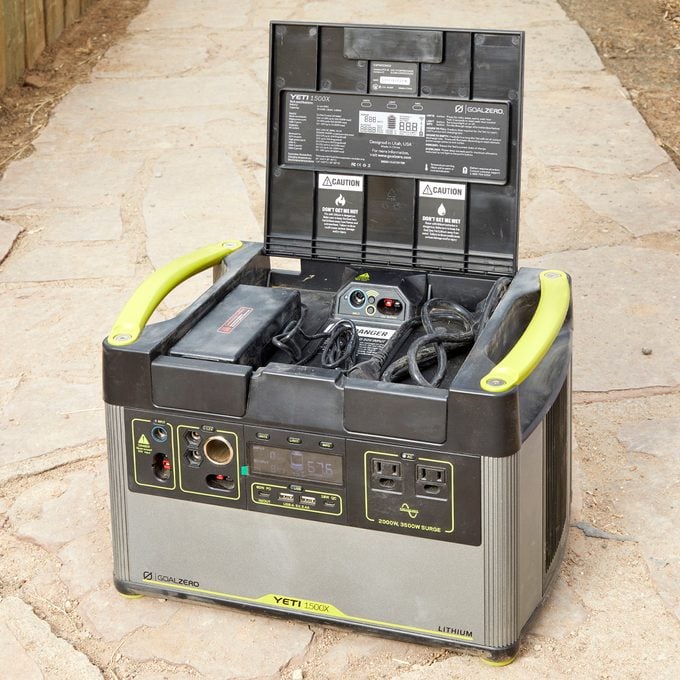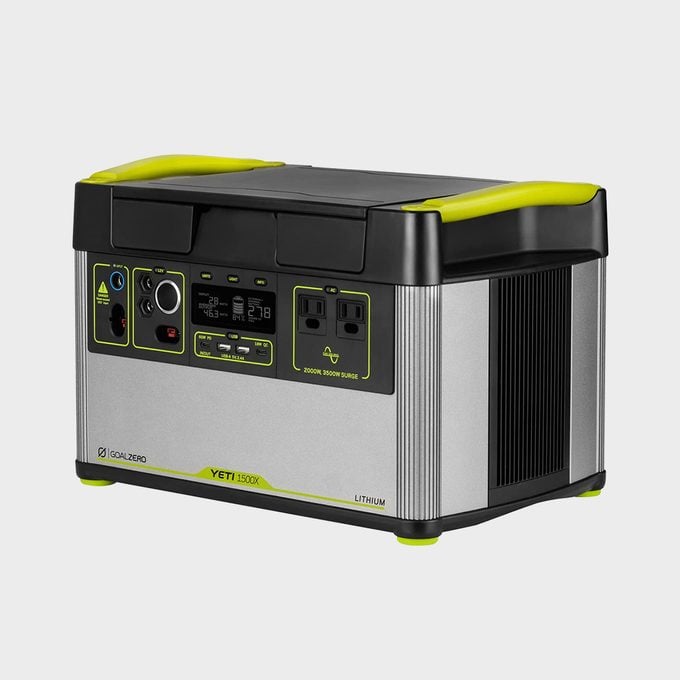We Tried the GoalZero Yeti 1500X Power Station and It Did Not Let Us Down
Updated: Jan. 29, 2024

Generators are becoming must-have tools for homeowners, whether for emergency backup or portable electricity. But they’re not all the same, and finding the right one will require you to answer a few questions.
Our editors and experts handpick every product we feature. We may earn a commission from your purchases.Learn more.
What can power stations do? Where will you use one? What will you plug in? How much should you spend? We looked at a few options and tested the GoalZero Yeti 1500X on a jobsite to help you choose the right generator for your needs.
On This Page
What is the GoalZero Yeti 1500X Power Station?

Is it a generator or power station? They’re all called “generators,” but that’s not accurate.
A generator uses a gas or diesel engine to make electricity. And noise. More power means more noise, which is fine on a jobsite but not when you’re at home or camping.
Then you have power stations or power inverters, i.e. portable tools that convert direct current (DC) from lithium-ion batteries into alternating current (AC). They don’t generate power; they store it. You recharge these tools by plugging them into a wall outlet, solar panel or even your truck’s DC outlet. Recharging can take hours.
How We Tested it
We took a GoalZero Yeti 1500X power station on a two-week backyard build in New Mexico. We had access to one wall outlet on the site. With multiple battery chargers, plug-in table and miter saws and our lighting equipment, plus cell phones and laptops, that single outlet couldn’t do it all.
Throughout the build we plugged in the GoalZero at night to recharge, then unplugged it during the day so it could be our power source for chargers, tools and phones. Charging cell phones is a nice convenience, especially with the USB outlets, but it’s not much of a test of this unit’s power.
We plugged in a photography strobe power pack, which draws more than the rated watts of the GoalZero but has a variable output. It gave our photographer ample power for his strobes and flash.
When we needed to plug in the DeWalt 10-in. jobsite table saw, one skeptical builder said, “No way.” He was pleasantly surprised when the GoalZero powered his saw, which draws 1,800 watts, to rip through several sheets of oriented strand board (OSB). Leaving the jobsite, I kept the power station next to the driver’s seat in the van and easily charged my phone during a two-day drive.
Outside for two weeks in a dusty, dirty and even snowy work environment, the GoalZero Yeti took some abuse. But its performance never wavered. With the solar charging option, this power station would serve builders in new construction or power up campsites nearly anywhere.
The GoalZero Yeti 1500X is powered by lithium-ion batteries with a 1,516 watt hours capacity. Plugged into a regular outside wall outlet, the station will charge in about 14 hours, according to the manufacturer. Its run-time depends on what you plug into it.
We started our 14-day project with the GoalZero at full charge. On some days we ran it down to about 30 percent. Plugged in at night, which we didn’t always remember to do, the unit would get close to a 100 percent charge.
Final Verdict
The unit’s LED screen provides plenty of data. The connected cell phone app does, too, while giving you individual power control of the device’s outlets. Weighing about 45 lbs. and retailing for about $2,000, the GoalZero Yeti 1500X is a heavyweight tool. After I used it on the job, I’d say it’s worth its weight.
A generator or portable power station can keep your refrigerator and internet modem running for hours when a storm knocks out power at your house. It can power up the battery packs for your chainsaw while you’re out cutting firewood. It can run lights, a stereo and a smoker for your next tailgate party.
To know what a portable power pack can do (I’m including generators in the category), you need to know its power output in watts. That rating is often in the unit’s name or model number. This will help you determine which appliances or tools you can power.
It’s good to understand watts. A generator rated at 1,500 watts will power devices with combined watts ratings of 1,500. Buy a larger generator than you think you need; some will provide power at only about 85 percent of its stated total rating.
You also need to know the “surge” or “max” output in watts. Some electric motors draw more power at startup than they do while running. Your refrigerator might have a starting wattage of 2,500 watts and a running wattage of 800. Make sure you buy a generator with a surge wattage of at least 2,500 to get that fridge started.
Look at the available port connection options on a portable power station. besides 120V AC outlets, you might want USB ports (both USB-A and USB-C) and a 12V connection. You also want to know your power generation options. Some generators run on gas, others on diesel. Some power inverters allow you to charge with a solar panel or two. And some use the same lithium-ion batteries as your power tools.
Finally, consider size and weight. If you need a generator for emergency home power, you want the largest generator you can afford, so portability is probably not a concern. But if you’re looking for a power pack for a jobsite or for camping, you need that perfect blend of size and power capacity.
Where to Buy the GoalZero Yeti 1500X

GoalZero Yeti 1500X is available at Amazon and some home improvement stores. You can also buy it directly from the GoalZero website.



















